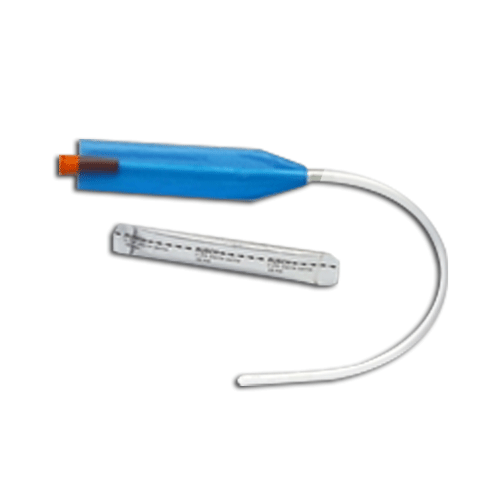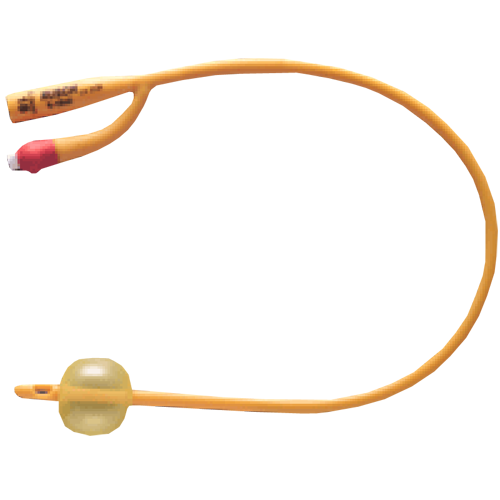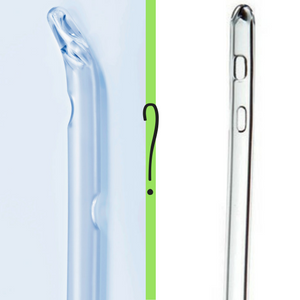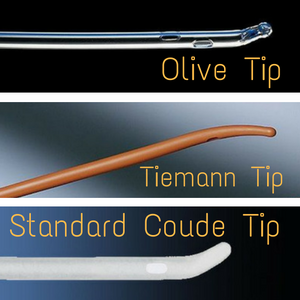Straight Tip vs Coude Tip Catheter

What is a Catheter?
 A catheter is a flexible tube that is inserted through a narrow opening into a body cavity, particularly the bladder, for removing fluid. That is the definition of the word catheter but there are many differences between them. Catheters are generally made from silicone, latex, or a combination of both. One type of catheter is called a Foley catheter. Once it is inserted into the bladder, a small balloon at the tip is inflated so the catheter can be held in place inside the bladder. Another type of catheter is referred to as an "intermittent catheter". Similar to the Foley, it is inserted into the urethra and then it is pushed into the bladder. Unlike the Foley, once the bladder is drained, it is removed immediately and discarded. People who use intermittent catheters use several a day, while people who use Foley catheters use the same one for a set period of time. Some companies, like Bard Medical, make Foley catheters, as well as intermittent catheters.
A catheter is a flexible tube that is inserted through a narrow opening into a body cavity, particularly the bladder, for removing fluid. That is the definition of the word catheter but there are many differences between them. Catheters are generally made from silicone, latex, or a combination of both. One type of catheter is called a Foley catheter. Once it is inserted into the bladder, a small balloon at the tip is inflated so the catheter can be held in place inside the bladder. Another type of catheter is referred to as an "intermittent catheter". Similar to the Foley, it is inserted into the urethra and then it is pushed into the bladder. Unlike the Foley, once the bladder is drained, it is removed immediately and discarded. People who use intermittent catheters use several a day, while people who use Foley catheters use the same one for a set period of time. Some companies, like Bard Medical, make Foley catheters, as well as intermittent catheters.
What is a Straight Catheter?

A straight catheter is a thin, flexible tube with a straight, cylindrical tip used primarily for intermittent catheterization—meaning it is inserted to drain the bladder and then removed. This type of catheter is commonly used by individuals with unobstructed urinary tracts and is considered the standard design due to its simplicity and ease of use.
Straight catheters come in a variety of materials, including latex, silicone, red rubber, and PVC, each offering different levels of flexibility and suitability for people with latex sensitivities. They are available in male, female, and pediatric lengths to accommodate anatomical differences.
Some models are hydrophilic or pre-lubricated for smoother insertion, while others require the application of a sterile lubricant before use. These options allow users to choose the best combination of comfort, safety, and convenience.
What is a Coude Catheter?
A coude catheter is a type of urinary catheter with a curved or angled tip designed to help navigate around obstructions in the urethra, such as an enlarged prostate (BPH), urethral strictures, or scar tissue. The bend in the tip allows the catheter to bypass these blockages more comfortably and safely than a straight tip catheter.
Coude catheters are available in both intermittent and Foley (indwelling) styles and can be found in a variety of materials and coatings, including hydrophilic (like Coloplast SpeediCath), pre-lubricated, and uncoated options. If your catheter is not pre-lubricated, you'll need to apply a sterile lubricant before use. Proper lubrication and insertion technique are important to minimize discomfort and reduce the risk of injury.
Some coude catheters include a guide stripe to help you align the curve in the proper direction—usually facing upward. There are also a few common tip variations, including:
- Olive Tip: A bent tip with a small bulb at the end that helps gently push past obstructions.
- Tiemann Tip: A longer, tapered, and more flexible tip that helps locate small or narrowed urethral openings.
Should I Use a Straight or Coude Catheter?

Choosing between a straight and coude catheter depends on your anatomy and whether you’ve experienced any discomfort or difficulty during catheter use.
When to Use a Straight Catheter
A straight catheter is often suitable for individuals with no known blockages or complications. If you’re able to insert and remove it without pain or resistance—especially when using a medical lubricant—a straight tip is likely the right choice.
When to Use a Coude Catheter
If you’ve experienced sharp pain, a sensation that the catheter is getting stuck, or have a medical history that includes an enlarged prostate (BPH), urethral strictures, or post-surgical scarring, a coude catheter may offer a more comfortable and effective solution. Its curved tip is specifically designed to navigate around these types of obstructions.
Because anatomy and comfort levels vary, you may need to try different coude styles to find the one that works best for you. Many medical supply companies, including Express Medical Supply, allow you to purchase single catheters, so you can test options without committing to a full box.
When in doubt, it’s always best to speak with your doctor or nurse. They can help evaluate your situation and recommend the catheter type that’s safest and most comfortable for your needs. Any pain or resistance during use should be addressed, as it may indicate the need for a different catheter style or size.

